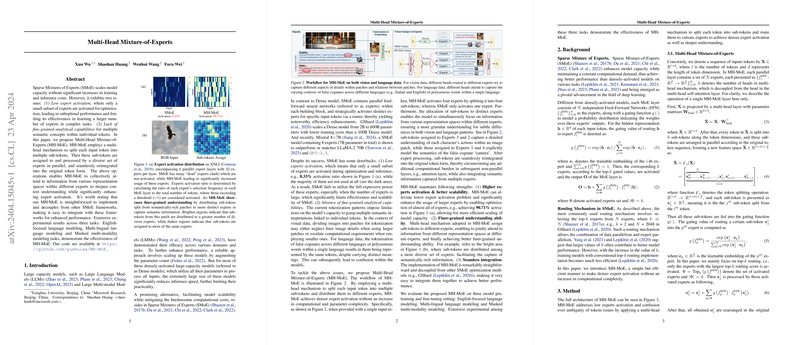Exploring the Capabilities of Multi-Head Mixture-of-Experts (MH-MoE) for Enhanced Model Performance
Introduction to Multi-Head Mixture-of-Experts (MH-MoE)
The paper introduces the Multi-Head Mixture-of-Experts (MH-MoE), an innovative approach addressing limitations in the Sparse Mixture of Experts (SMoE) models. Specifically, MH-MoE targets two major issues in SMoE:
- Low expert activation, limiting the model's capacity to leverage its full set of computational resources efficiently.
- A lack of fine-grained analytical capabilities needed to discern subtle semantic variances.
MH-MoE evolves the SMoE architecture by incorporating a multi-head mechanism to split input tokens into multiple sub-tokens. These sub-tokens are processed by distinct experts and then reintegrated, promoting stronger expert utilization and nuanced contextual comprehension.
Key Features and Implementation of MH-MoE
MH-MoE enhances model performance through several key strategies:
- Denser Expert Activation: By splitting tokens into multiple sub-tokens and routing them to different experts, MH-MoE achieves high levels of expert utilization without additional computational expense.
- Enhanced Contextual Understanding: The discrete processing of sub-tokens by multiple experts allows the model to integrate diverse perspectives and semantic nuances potentially missed by single-expert processing.
- Ease of Integration: Maintaining simplicity in its structural modification, MH-MoE can be seamlessly integrated with existing SMoE models, improving their performance while leveraging their established strengths.
Technical Insights and Implementation
MH-MoE operates on a straightforward principle where each token is split into multiple sub-tokens that are independently processed by different experts. This process includes:
- Token Splitting: Each input token is divided into sub-tokens, distributed across several heads.
- Expert Processing: Each expert independently processes its assigned sub-tokens.
- Token Merging: Post processing, sub-tokens are reassembled into their original token format.
This architecture not only diversifies the input handling characteristic of the model but also enriches the output with a more comprehensive representation derived from multiple expert analyses. The implementation noted in the paper confirms that the additional layers (multi-head and merging layers) introduced in MH-MoE do not significantly alter the model's computational overhead, making it a cost-effective enhancement to SMoE frameworks.
Experimental Results and Evaluation
The paper outlines extensive experiments conducted across varied tasks such as English-focused and multi-lingual LLMing, and masked multi-modal modeling. MH-MoE consistently demonstrated superior performance in terms of activation metrics and task-specific performance measures like perplexity and accuracy across different datasets. Notably, the model achieved a remarkable 90.71% activation rate showcasing its effective utilization of available experts, in stark contrast to traditional SMoE configurations.
Future Directions and Theoretical Implications
The introduction of MH-MoE marks a significant shift towards optimizing expert utilization and enhancing semantic analysis capabilities in large model architectures. Future research could expand on this approach by exploring:
- Scalability: Investigating the impacts of scaling the number and complexity of experts and heads within the MH-MoE framework.
- Domain-Specific Applications: Adapting MH-MoE for specialized tasks in fields like biomedicine or finance where nuanced interpretation of vast data is crucial.
- Integration with Other AI Technologies: Combining MH-MoE with other AI advancements like reinforcement learning or unsupervised learning algorithms to explore new application territories.
In essence, MH-MoE not only addresses critical gaps in existing SMoE frameworks but also opens new avenues for research and application in the broader field of machine learning and AI.
